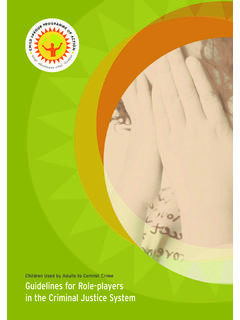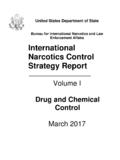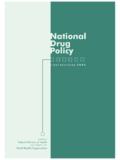Transcription of EXECUTIVE SUMMARY CONCLUSIONS AND …
1 EXECUTIVE SUMMARY CONCLUSIONS AND POLICY IMPLICATIONS1 WORLD drug REPORT2017 This booklet constitutes the first part of the World drug Report 2017. united nations , May 2017. All rights reserved : 978-92-1-148292-8 eISBN: 978-92-1-060624-0 united nations publication, Sales No. publication may be reproduced in whole or in part and in any formfor educational or non-profit purposes without special permission fromthe copyright holder, provided acknowledgement of the source is united nations office on Drugs and crime (UNODC) would appreciatereceiving a copy of any publication that uses this publication as a citation: united nations office on Drugs and crime , World drug Report 2017 (ISBN: 978-92-1-148291-1, eISBN: 978-92-1-060623-3, united nations publication, Sales No. ).No use of this publication may be made for resale or any other commercialpurpose whatsoever without prior permission in writing from for such permission, with a statement of purpose and intent of thereproduction, should be addressed to the Research and Trend Analysis Branch of content of this publication does not necessarily reflect the views orpolicies of UNODC or contributory organizations, nor does it imply any on the report are welcome and can be sent to:Division for Policy Analysis and Public AffairsUnited nations office on Drugs and CrimePO Box 5001400 Vienna AustriaTel: (+43) 1 26060 0 Fax: (+43) 1 26060 5827E-mail.
2 The World drug Report 2017 clearly shows, there is much work to be done to confront the many harms inflicted by drugs, to health, development, peace and security, in all regions of the , there are an estimated minimum of 190,000 in most cases avoidable premature deaths from drugs, the majority attributable to the use of terrible impact of drug use on health can also be seen in related cases of HIV, hepatitis and tuberculosis. Much more needs to be done to ensure affordable access to effective scientific evidence-based preven-tion, treatment and care for the people who desperately need them, including those in prison settings. As just one example, this year s report high-lights the need to accelerate accessibility to the treatment of hepatitis C, a disease whose negative health impact on people who use drugs is far greater than that of HIV/AIDS. Recent attention has focused on the threats posed by methamphetamine and new psychoactive sub-stances (NPS).
3 However, as the report shows, the manufacture of both cocaine and opioids is increas-ing. These drugs remain serious concerns, and the opioid crisis shows little sign of stopping. The World drug Report 2017 further looks at the links with other forms of organized crime , illicit financial flows, corruption and terrorism. It draws on the best available evidence and, most of all, high-lights the fact that much more research needs to be carried out in these areas. Corruption is the great enabler of organized crime , and opportunities for corruption exist at every stage of the drug supply chain. However, too little is known about how different types of corruption interact with drug markets. The outcome document of the special session of the General Assembly on the world drug problem and I am proud to say that this year we are marking 20 years of the World drug the past two decades, the united nations office on Drugs and crime (UNODC) has been at the forefront of global research into complex areas of drug use and supply, supporting international cooperation and informing policy choices with the latest estimates, information on trends and year we are launching a new format, with the report available as five separate booklets: the execu-tive SUMMARY , together with the report s CONCLUSIONS and policy implications; a global overview of drug use and supply; a market analysis of plant-based drugs; a market analysis of synthetic drugs; and a thematic booklet on the links between drugs and organized crime , illicit financial flows, corruption and terrorism.
4 We have done this in response to readers needs and to improve user-friendliness, while maintaining the rigorous standards expected from the office s flagship publication. The 2017 report comes at a time when the interna-tional community has acted decisively to achieve consensus on a way forward for joint outcome document unanimously adopted at last year s special session of the General Assembly on the world drug problem contains more than 100 concrete recommendations for implementing bal-anced, comprehensive and integrated approaches to effectively addressing and countering the world drug problem. Moreover, at its sixtieth session, in March 2017, the Commission on Narcotic Drugs adopted resolution 60/1, reinforcing commitment to implementing the outcome document and charting a course to the 2019 target date of the 2009 Political Declaration and Plan of Action on the world drug problem, as well as strengthening action towards the Plan of Action s agreed goals and targets.
5 PREFACE WORLD drug REPORT 20174As the special session of the General Assembly and the recent session of the Commission on Narcotic Drugs have shown, the international community is equipped to respond swiftly and decisively to global drug -related challenges. For example, in March, the Commission scheduled two precursors and an analogue to the scheduled drug fentanyl. This important step will make it harder for criminals to illicitly manufacture fentanyl and its analogues and, I hope, can help to stem the tragic increase in opioid overdoses in recent years. However, there remains an enormous need for capacity-building and technical assistance, and fund-ing continues to fall far short of political commitment. Further resources are urgently needed to help all Member States implement the recom-mendations contained in the outcome document of the special session of the General Assembly and achieve related targets under the Sustainable Devel-opment many evolving drug challenges also highlight the importance of prevention science- and rights-based drug use prevention but also prevention of crime , corruption, terrorism and violent extrem-ism, in line with commitments under the conventions and united nations standards and norms.
6 Finally, I ask all Governments to help us improve the evidence base for these reports. Areas such as the links between drugs, terrorism and insurgency clearly touch upon sensitive intelligence, and there are legitimate concerns about compromising sources, collection and operations. But if we want to effec-tively address drug challenges we need to strengthen international cooperation and information-sharing to the extent possible, to close the gaps and ensure that joint action is targeted, effective and timely. Yury FedotovExecutive DirectorUnited nations office on Drugs and CrimeSecurity Council resolutions express concern about terrorist groups profiting from drug trafficking, among other forms of transnational organized is well established that there are terrorists and non-State armed groups profiting from the drug trade by some estimates, up to 85 per cent of opium poppy cultivation in Afghanistan is in terri-tory under influence of the Taliban. However, evidence on the organized crime -terrorism nexus remains patchy at best.
7 Moreover, these links are not static. Relations between organized crime and terrorists groups are always evolving, much like drug markets we have seen with the NPS market, drug use, supply, trafficking routes and the substances them-selves continue to shift and diversify at alarming speed. Drugs continue to represent a major source of rev-enue for organized crime networks, but business models are changing, with criminals exploiting new technologies, such as the darknet, that are altering the nature of the illicit drug trade and the types of players involved, with looser, horizontal networks and smaller groups becoming more significant. New ways of delivering drugs further point to the need to involve other sectors such as postal services in the fight against drug trafficking. Clearly, countries must be able to act and react to an ever-changing and formidable array of threats and problems. UNODC is fully engaged in strength-ening responses, working closely with our united nations partners and in line with the international drug control conventions, human rights instruments and the 2030 Agenda for Sustainable Development, which are themselves complementary and mutually BOOKLET 1 EXECUTIVE SUMMARY CONCLUSIONS AND POLICY IMPLICATIONSBOOKLET 2 GLOBAL OVERVIEW OF drug DEMAND AND SUPPLY Latest trends, cross-cutting issuesBOOKLET 3 MARKET ANALYSIS OF PLANT-BASED DRUGSO piates, cocaine, cannabisBOOKLET 4 MARKET ANALYSIS OF SYNTHETIC DRUGS Amphetamine-type stimulants, new psychoactive substancesBOOKLET 5 THE drug PROBLEM AND ORGANIZED crime , ILLICIT FINANCIAL FLOWS, CORRUPTION AND TERRORISMPREFACE.
8 3 EXPLANATORY NOTES ..7 EXECUTIVE SUMMARY ..9 Who suffers the heaviest burden of disease from drug use? ..11 drug market diversification ..13 The drug market is Flux in drug flows ..18 Cannabis market developments ..20 Changing business models for drug trafficking and organized crime ..21 drug crime proceeds damage economies in the long term ..22 Corruption facilitates illicit drug markets, which fuel corruption ..23 drug trade benefiting some terrorist, insurgent and non-State armed groups ..23 Scarcity of reliable data on terrorism and corruption ..25 CONCLUSIONS AND POLICY IMPLICATIONS ..27 GLOSSARY ..33 REGIONAL GROUPINGS ..34 AcknowledgementsThe World drug Report 2017 was prepared by the Research and Trend Analysis Branch, Division for Policy Analysis and Public Affairs, united nations office on Drugs and crime , under the supervision of Jean-Luc Lemahieu, Director of the Division, and Angela Me, Chief of the Research and Trend Analysis Branch. Review and commentsThe World drug Report 2017 benefited from the expertise and invaluable contributions of UNODC colleagues in the drug Prevention and Health Branch of the Division for Operations; the Corruption and Economic crime Branch, the Organized crime and Illicit Trafficking Branch and the Terrorism Prevention Branch of the Division for Treaty Affairs; and the Research and Trend Analysis Branch of the Division for Policy Analysis and Public Affairs.
9 The Research and Trend Analysis Branch acknowledges the contribution to the section on drugs, terrorism and insurgency by the Illicit Crop Monitoring team of the UNODC country office in Research and Trend Analysis Branch also acknowledges the invaluable contributions and advice provided by the World drug Report Scientific Advisory Committee:UNODC gratefully acknowledges the contribution of Masoud Dara and Annabel Baddeley of the World Health Organization to the section on also gratefully acknowledges the comments and advice provided on the section on drugs, terrorism and insurgency by the Analytical Support and Sanctions Monitoring Team of the united nations Security research and preparation of the joint UNODC/UNAIDS/WHO/World Bank estimates of the number of people who inject drugs were partly funded by the HIV/AIDS Section of the drug Prevention and Health Branch of the Division for Operations of UNODC. Jonathan CaulkinsPaul GriffithsMarya HynesVicknasingam B.
10 KasinatherLetizia Paoli Charles ParryPeter ReuterFrancisco ThoumiAlison RitterBrice De RuyverGeneral coordination and content overviewChlo Carpentier Angela Me Analysis and draftingConor Crean Philip Davis Natascha EichingerSusan IfeagwuSabrina LevissianosKamran Niaz Thomas Pietschmann Martin RaithelhuberAgata Rybarska Justice TetteyData management and estimates production Enrico Bisogno Coen Bussink Jesus Maria Garcia Calleja (WHO)Riku Lehtovuori Tun Nay SoeAndrea OterovaUmidjon RakhmonberdievAli Saadeddin Keith Sabin (UNAIDS) Antoine Vella Lorenzo Vita EditingJoseph BoyleJonathan GibbonsGraphic design and productionAnja KorenblikSuzanne KunnenKristina KuttnigCoordination Francesca MassanelloData SupportDiana CameriniRaffaella ConconiSarika DewanAdministrative supportAnja Held Iulia Lazar7 EXPLANATORY NOTES The boundaries and names shown and the designa-tions used on maps do not imply official endorsement or acceptance by the united nations . A dotted line represents approximately the line of control in Jammu and Kashmir agreed upon by India and Paki-stan.















